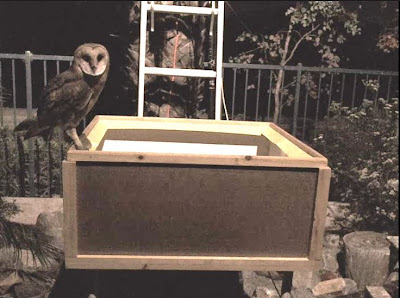 How do owls catch their food?
How do owls catch their food?Owls generally have a hunting territory away from their daytime roost. All Owls are equipped with special adaptations that make them efficient predators. Keen eyesight allows them to locate prey even on dim nights. Sensitive, directional hearing helps locate concealed prey.
Some species can even hunt in complete darkness using sound alone to guide them to a successful kill. An Owl's flight is silenced by special wing feathers, that muffle the sound of the air rushing over the surface of the wing. This allows an Owl to hunt by stealth, taking their victims by surprise. It also allows the Owl to listen for prey movements while still flying.
Most species hunt from a perch, such as a low branch, stump or fence post. They will wait for prey to appear, and swoop down with open wings, and their talons stretched forward.
Some species will fly or glide a little way from the perch before dropping on the victim. In some cases, the Owl may simply drop on the target, opening their wings at the last moment. Other owl species prefer to soar, or make quartering flights, scanning the ground below for a suitable meal. When a target is located, the Owl will fly towards it, keeping its head in line with it until the last moment. This is when the Owl pulls its head back, and thrusts its feet forward with the talons spread wide - two pointing backwards and two forwards. The force of the impact is usually enough to stun the prey, which is then dispatched with a snap of the beak.
A 3rd owl flies onto the playground. Was this a fake handoff and a beaking friendly gesture or was this an attempt to attack or chase away?
Well that depends on who you ask.. What do you think??
If you have a facebook account, you may be able to view the video HERE



